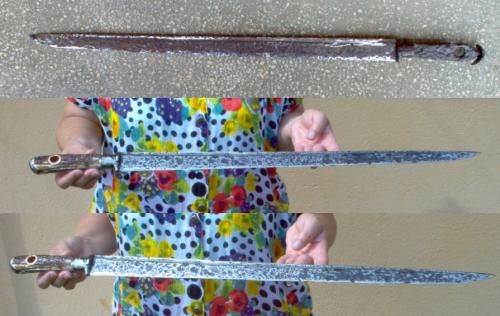Posts: 1,757 Location: Storvreta, Sweden
Mon 27 Aug, 2007 11:41 pm
Here are examples of these knives from the Swiss Landesmuseum in Zürich
I attach three Rugger. Note the long narrow pointy blade and simple hilt. Components can vary a little, but they are all mounted by basically the same principles: pomel cap and two sturdy plates or bars forming the collar towards the blade. My impression is that later examples has a longer "neck" on this collar. There is normally also a "nagel" or nuckle bar-lug.
The blade can be thick in the spine and the cross section is triangular. It seems some examples are thinner and slightly wider. Some have a narrow fuller or grove along the back.
I also attach two images of knives that may be called Hauswehr or bauernwehr. I am under the impression that the more ornate types usually are called Bauernwehr, but that the two names are interchangeable. They denote sturdy knives that can duble as weapons, but are carried as big utility knives. Quite like bowie knives. They commonly came in scabbard with by-knives and steels. (This seems to have been the case for Ruggers as well)
In Swedish medieval texts a knife type weapon is sometimes named as a "Ryting". I think that a big personal knife like the Rugger or a big version of the Bauernwher is meant. I don´t know for sure, however.
I hope some one else would post on this and confirm or provide more detailed info. The terms and names for these knives are not always clear in litterature. The Rugger seems to be quite distinct from the Hauswehr/auernwehr knives hovever.
A Rugger has a length like that of a short sword and is always pretty pointy.
The bauernwehr are wider in proportion and shorter. They often but not always have a clip point and are less dagger like in outline.
 Attachment: 17.47 KB
Attachment: 17.47 KB

A Bauernwehr, 16th C. Length 32 cm, width 3,7 cm.
 Attachment: 25.67 KB
Attachment: 25.67 KB

A Hauswehr (?), first half 16th C. Length 33,5 cm, width 3,2 cm
 Attachment: 36.87 KB
Attachment: 36.87 KB
A Rugger, second half 15th C. Length 56,5 cm, width 3 cm. [ Download ]
 Attachment: 51.05 KB
Attachment: 51.05 KB
Another Rugger, about 1500. Length (broken) 56,5 cm, width 6 cm.
(I wonder if this one might not actually qualify as a Grossemesser of the sword type?) [ Download ]
 Attachment: 29.6 KB
Attachment: 29.6 KB
A third Rugger, first half 16th C. Length67,8 cm, width 4,1 cm. [ Download ]




